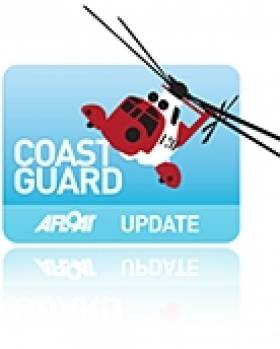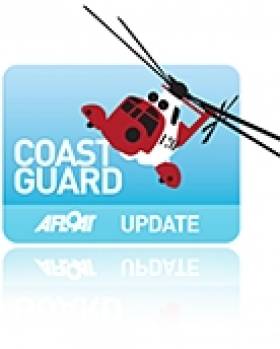Displaying items by tag: SAR
Coast Guard Winchman Retires after 30 Years' Service
Noel Donnelly (55), who is retiring after more than 30 years' service, worked as winchman and paramedic. He completed his last shift at the Sligo Coast Guard search and rescue base last week and retires officially this month.
Originally from Tyrone, Mr Donnelly began his career with the Air Corps, flying in Alouette and Puma helicopters. He left in 1984 to take a job as a diver with a civil engineering firm in Aberdeen, Scotland, and subsequently worked as an ambulance driver in Co Kildare. For more about this article please click here
ComReg launches Personal Locator Beacon (PLB) Registration Website
Personal Locator Beacons, or PLBs, are portable radio transmitters, which aid the Search & Rescue (SAR) emergency services in the detection and location of persons in distress. These devices operate in a similar manner to Emergency Position Indicating Radio Beacon (EPIRBs) onboard vessels and Emergency Locator Transmitters (ELTs) onboard aircraft, but are unique in that they for personal use and are not registered to a particular vessel or aircraft.
ELTs and EPIRBs have been in operation for several years are proven technologies, which have resulted in many successful search and rescues missions since their inception. More recently technological advances have enabled the construction of light-weight, hand-portable distress transmitters and hence the relatively recent emergence of PLBs onto the market.
In order to maximise the effectiveness of PLB usage, each PLB should be registered so that owner details as well as location details can be communicated to the emergency services which in many cases assists in speeding up rescue operations.
PLB owners can now register their PLB in Ireland using ComReg's new web portal. For more information on how to register your PLB please go to www. Comreg.ie or contact [email protected] or phone 01 804 9600.
New SAR Contract Will Have Wide Range of Tasks
The new SAR contract signed by Minister Dempsey this morning will se CHCI provide five Helicopters that are four Prime Helicopters and a Back Up Helicopter based initially at Shannon Airport. The first S92A will be commissioned at Shannon in the second half of 2012.
The Helicopters are maintained at a state of readiness of not more than 15 minutes from 0830 to 2200 local time, and not more than 45 minutes from 2200 to 0830 local time for each and every day of every year.
Possible Taskings include:
Undertaking SAR operations by day and night, including landing at remote inland areas and hospital landing sites for the purpose of lifting and delivering casualties.
Providing Paramedic-trained and accredited rear crew to assist and evacuate casualties and potential casualties from the sites of appropriate major emergencies on land, including flooding and providing an onboard emergency medical service.
Delivering trained Fire Brigade personnel and trained fire fighting teams with their equipment to ships at sea to direct the fighting of fires. The standard team consists of six personnel and six bags (a total of 900 kg) and must be carried in a single lift.
Delivering trained Health Service Executive (HSE) Marine Ambulance Response Teams (MART) or a similarly equipped and trained medical response team to ships at sea while equipped with Standard Role Equipment and relevant Carry-On Equipment.
Delivering a contractor-owned and maintained pump to vessels that are taking in water faster than their own pumps can handle.
Delivering a normal mountain or cliff rescue team to remote areas throughout Ireland and working with them in the search and rescue of stranded and/or injured people.
Recovering casualties from and operating with RNLI and other rescue boat operators.
Providing an emergency service for the communities on the islands off the west coast. As well as evacuating sick and injured people where life is at risk. The Helicopters may also be tasked to provide assistance in the event of major emergencies such as a fire, flood or deep snow.
Visually assessing, videoing, photographing and sampling marine pollution to assist the containment and dispersion process and to contribute evidence for prosecution and attending court if required.
Carrying loads within the Helicopter's capability, such as equipment to counter marine pollution and flooding.
Carrying ships' pilots and IRCG coordinated search, response, emergency or investigation personnel to and from vessels, installations, incident sites and islands as required.
Assisting the Principal Response Agencies (Garda, HSE, and local authorities), Defence Forces and other Government Departments as required in emergency situations.
Delivering Garda, Navy or similar Water Unit Minimum Dive Teams and their equipment in a single lift to a land destination near the scene of water rescues.
Provide a distress monitoring, and when necessary a communication and coordination service on VHF marine frequencies when airborne.
Crew Experience:
Captains
Total helicopter hours 2500 hours
Hours in command of multi-engined helicopters 1000 hours
Hours on type 250 hours*
Hour in command on type 100 hours*
Co-Pilots
Total helicopter hours 750 hours
Hours on multi-engined helicopters 350 hours
Hours on type 50 hours
Winch Operators
At least one year's experience as a Winch Operator on a dedicated military or civilian SAR unit and at least the EMT qualification accredited by PHECC.
Winchpersons
At least three months experience as a Winchperson on a dedicated military or civilian SAR unit and at least the Paramedic qualification accredited by PHECC.
The S92A:
The S92A will:
• Hover in strong wind up to 35 knots crosswind and tailwind.
• Land, shut down and start on ground sloping up to 10 degrees nose up or down, 13 degrees laterally.
Aircraft Equipment:
• Active Vibration Control to provide better patient care and reduce crew fatigue.
• Composite Blades providing optimised cruise and hover performance at reduced fuel burn rates.
• Modern Cockpit Display System (CDS) affording pilots with greater amounts of available information, allowing for greater safety and situational awareness.
• A 4 Axis Automatic Flight Control System (AFCS) with Flight Director and Auto Hover capability to assist aircrew by providing automated search patterns and pinpoint transitions to and from the hover targets of interest regardless of day of day of weather conditions.
The S92A has one of the largest cabins of any helicopter in its class. At twenty feet long (6.10m) 6' 6" inches feet wide (2.01m) and 6' high (1.83m) the cabin is high enough for the crew to stand, move, manoeuvre patients without injury and deliver patient care effectively.
The aircraft standard range is in the region of 270 nautical miles that can be extended to over 300 nautical miles if required that allows for 30 minutes on scene and can lift over 20 survivors at maximum range. At 60 nautical miles 33 survivors can be recovered.
Maximum speed is in excess of 150 knots.
The Rotor Ice Protection System allows flight in icing conditions up to a maximum of 10,000 ft. The system also includes engine anti-icing through electrical and bleed air heating.
The contract, will provide SAR services from bases at Waterford, Dublin, Shannon and Sligo from 2012 onwards. CHC already provides SAR services from these bases but the new contract will see the existing fleet of S-61N aircraft replaced with newer Sikorsky S-92A helicopters that are custom fitted for SAR work.
Irish Coast Guard Director Chris Reynolds said, "The Irish Coast Guard provides a diverse range of maritime and land-based SAR activities, ranging from national emergency situations such as the recent flooding seen in Ireland last winter to medevac from our Islands, mountains, fishing vessels and incidents involving leisure activity."
"It is essential we have the right stepped increase in capabilities going forward for the next decade. We are very confident in selecting CHC Helicopter that our decision will continue to deliver excellence, providing the most efficient and effective SAR service for Ireland."
The Irish contract cements CHC Helicopter's position as a world leader in provision of civilian SAR services. In addition to the service already provided in Ireland, CHC currently provides SAR coverage in Australia and the UK, and through its membership in the Soteria consortium, has been identified as the preferred bidder on the UK SAR-H program, a 25-year contract to provide helicopter-based SAR services from 12 bases throughout the UK.
"CHC is internationally recognised as a provider of effective SAR solutions to customers worldwide. In today's very challenging environment, we offer the most efficient, reliable and effective services using industry leading technology," said Tilmann Gabriel, chairman of CHC Ireland and president of CHC Helicopter's European Operations.
Mark Kelly, Managing Director of CHC Ireland, added that Irish citizens could now expect to see many positive changes arise.
"Over the next decade this contract will offer a number of service improvements including the ability to deliver a paramedic to any SAR incident within an hour anywhere on our coastline, ensuring much faster treatment of casualties," he said.
CHC is the world's largest operator of the Sikorsky S-92 helicopter that has a long and distinguished pedigree in SAR operations. There are currently more than 100 S-92 helicopters in operation around the world with a fleet total approaching 250,000 flight-hours.
The state-of-the-art twin-engine aircraft will be specially equipped for SAR operations and capable of flying faster and farther than aircraft currently in use. As well as longer range and improved cruising speeds, the S-92s will be equipped with enhanced rescue mission technology including infra-red and low light cameras, a Nightsun searchlight, a satellite communications system featuring a Flight Following tracking facility, and high speed dual hoists.































































